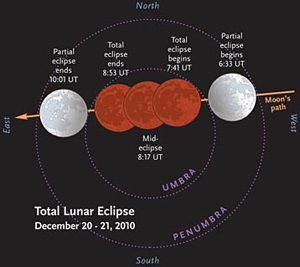Those of you who live in the North America* will be treated to a total lunar eclipse tomorrow night (Monday night/Tuesday morning)! The whole thing unfolds over about 3.5 hours, starting at 1:30 a.m. Eastern time.
Lunar eclipses are cool, but slow. They’re not like solar eclipses which last a few minutes at most; the shadow of the Earth is quite large, and it takes the Moon a while to move through it (also unlike a solar eclipse, lunar eclipses are perfectly safe to watch with your eyes, with binoculars, or through a telescope without protection). Not only that, there are two parts to the shadow: the outer penumbra, which is very difficult to see when it falls on the Moon, and the much darker umbra, which is what really casts the Moon into the dark. In other words, things really gets started when the Moon moves into the umbra.
 Sky and Telescope’s website has an excellent description of the timeline. The Earth’s dark shadow takes its first bite starting around 1:32 a.m. Eastern time (all times will be Eastern from here on out). Over the next 45 minutes or so, the Moon will plunge deeper into shadow, and the entire disk will be covered starting at 2:41 a.m. It’ll stay this way for over an hour, and then at 3:53 a.m. will begin to leave the shadow. An hour or so later, at 5:00 a.m., it’s all over, and the Moon will be restored to being full. Note that the farther west you are, the earlier this happens in the evening. For me, in Mountain time, it starts at the much more palatable 11:32 p.m. Monday night.
Sky and Telescope’s website has an excellent description of the timeline. The Earth’s dark shadow takes its first bite starting around 1:32 a.m. Eastern time (all times will be Eastern from here on out). Over the next 45 minutes or so, the Moon will plunge deeper into shadow, and the entire disk will be covered starting at 2:41 a.m. It’ll stay this way for over an hour, and then at 3:53 a.m. will begin to leave the shadow. An hour or so later, at 5:00 a.m., it’s all over, and the Moon will be restored to being full. Note that the farther west you are, the earlier this happens in the evening. For me, in Mountain time, it starts at the much more palatable 11:32 p.m. Monday night.
To someone viewing from the United States, you’ll see the eclipse start on the lower left part of the Moon. It really will look like a bite is taken out, and that dark bite will grow left to right. When the Moon begins to leave the shadow you’ll see the upper left part of the Moon becoming bright, with the illumination growing from left to right.
It’s hard to predict what you’ll see during that hour of totality. As weird as it is to believe, sometimes the Moon gets so faint it’s hard to see at all. I remember when I was in high school there was a lunar eclipse so deep I had to search the sky to find the Moon! It was that hard to spot, and really odd. But sometimes, atmospheric conditions on Earth will cast an eerie, blood-red shadow on the Moon. You can see that in the eclipse sequence picture above; during a 2007 eclipse Greek amateur astronomer Anthony Ayiomamitis captured the orange-red color of the Moon during totality. I’ve seen this many times myself, and it’s really quite stunning, and worth staying up (or getting up early) to see. Also, the Moon does not pass directly through the center of the Earth’s umbral shadow, so the top and bottom halves of the Moon may be dramatically different in appearance and color. There’s no way to predict this, so you’ll just have to go out and see for yourself.
If it’s cloudy where you are, or you’re on the wrong side of the planet, never fear: you can still get a look because NASA is hosting a live chat and video feed of the eclipse! JPL has set up a Flickr page for people to post their pictures of the eclipse, too.
If you Americans miss this eclipse, you’ll have to wait over three years before the next one, which occurs on April 14, 2014. Europe, Africa and Asia get the next lunar eclipse on June 15, 2011. Also, Africa, Europe, and parts of Asia are treated to a partial solar eclipse on January 5, 2011, in just two weeks! See Fred Espenak’s eclipse website for details.
Image credits: Anthony Ayiomamitis; Sky and Telescope.
* It’s visible in South America and in western Europe and Africa, but the sun rises in the middle of the eclipse; it’s also visible in Australia, New Zealand, and extreme eastern Asia, but the eclipse will have already started at moonrise.